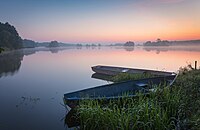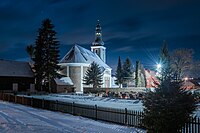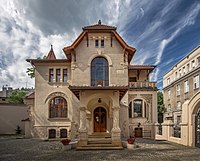CEE/Newsletter/November 2017/Contents/Poland report
Poland report: Celebrating Wikipedia milestone, WikiVacations 2017 results, and participation in the Digital Humanities
[edit]1 250 000 articles on Polish Wikipedia
[edit]Shortly before midnight on November 10th Polish Wikipedia reached an impressive milestone of 1 250 000 articles. The historical article was written by user Nedops and was about Estlé Viljoen, the South African female athlete.
It is quite symbolic that after the year in which we did a lot to fight the content gender gap, the milestone article is about a notable woman. There is still a lot of work in front of us (only about 15% of biographies being created in Polish Wikipedia are about women) but we are hopeful that projects like Wikipedia is also a woman! or special prizes for people creating articles about women in writing contests (for example CEE Spring) will help us to make those numbers better.
1 250 000 is an impresive number but quantity is not all we are about. Polish Wikipedia has been focusing more and more on the quality of the content. This year out community increased the number of Featured and Good Articles in Polish Wikipedia by 287 reaching the total number of 3426. Now how quality articles are 2,74‰ of the whole Polish Wikipedia content. And we hope that this will also rise in the future.
WikiVacations 2017 results
[edit]On November 1st the 20 winning photographs of the WikiVacations 2017 contest were announced. Photos were selected by the jury consisting out of professional photographers, journalists, wikimedians and a representative of the National Heritage Institute of Poland. The task was not easy: they had to choose out of more than 5000 pictures of Polish nature, monuments and art. And the decisions was even more difficult because of the overall high quality of the photos.
About 90% of the pictures were technically correct. You can see that the authors worked carefully with the light, that they had mastered the art of photographing architecture - says Kacper Krajewski, a professional photographer and a member of the WikiVacations 2017 jury. And adds - Also, judging by the effects, you can see that a number of participants had really improved their technique.
Another jury member, Jacek Halicki (winner of Polish edition of Wiki Loves Monuments in 2013 and 2014 and the author of more than 11,000 pictures uploaded to Wikimedia Commons) points out that this year the winning photos have more artistic value. He explains - In choosing our winners we focused more on the quality and the form of the pictures. This was not a contest for the most encyclopaedic or informative picture but for the most beautiful one.
In the final turn, the jury chose 20 best pictures of the whole contest and 3 best pictures in two thematic categories (Monuments and Nature). The jury decided not to award any pictures in the Public Monuments category.
Authors of the best pictures received photographic equipment and accessories of their choice. And all of the awarded monuments' photos were submitted to the Wiki Loves Monuments international finale.
Best Image
[edit]Best Images of Nature
[edit]-
First place Morskie Oko Lake, author: Aneta Pawska
-
Second place Wołowiec Mountain author: Tomasz Góra
-
Third place Pieniny National Park, author: Qvidemus
Best Images of Monuments
[edit]-
First place Saint Andrew church in Trzebieszowice, author: Poconaco
-
Second placeChurch of St. Mary in Gdańsk, author: Aneta Pawska
-
'Third place Leopold Kindermann Villa, author: Sławomir Milejski
Impressions from the Digital Humanities conference in Estonia
[edit]- Klara Sielicka-Baryłka, National Ethnographic Museum, Warsaw
Gray beginning of November can be expected if you are invited to a conference in beloved Estonia and Wikimedia Poland which you are a huge fan of decides to finance this event for you. It really happened to me; I had the unique chance to attend Open licences, open content, open data: tools for developing digital humanities conference which took place in Tartu, 1-3 Nov 2017.
As the organizers wrote:
- The main goal of the conference is to inspire and educate about the benefits of opening up the content in public collections and to build bridges between the more academic digital humanities community and the staff of memory institutions (archives, museums, libraries, galleries). With sessions on: visual data, open GLAM, open data, wiki platforms, open licences across Europe, goals and results of dh in higher education.
My presentation "Ethno-wiki projects as an example how not to lose human component in digital humanities" was approved by Wikimedia Eesti and other conference organizers and included in the paralel session on the 1st day. In my abstract, I stated:
- We are seeing a growing number of digital projects that are related to the material and non-material heritage of the entire world. Google Arts & Culture, Europeana, Wikimedia Commons and Wikipedia, digital collections of museums and archives – they all want to collect, protect, show what man created: inspired by the beauty of the world and his own spirit. But how do you not get lost in the mass of digitized objects, thousands of written words of the most important – the other man? On the example of ethnographic and Wikipedia projects ("Ritual Year with Wikipedia", “Ethnography of the Carpathians"), I want to talk about how the OpenGLAM movement can and should place in the first place the biography of man and the biography of his work and the biography of the researcher, collector, digitizer without loss for digital reality.
It was really interesting to talk to almost non-museum audience about this ethnographic-museum-wiki projects and compare this for example to Letters of 1916 project (coordinated by Susan Schreibmann) from Ireland or to the work done by Outi Valo on Finnish folk music collector. I also heard a lot of similarities in GLAM cooperation, while listening to Outi Penninkangas from Museum of Games. Asaf Bartov's speech about Wikidata was something that guided me to the new era of my Wikipedian life, so the next day I attended his workshop, too, and I am quite addicted if you ask me about Wikidata ethnographic/museum content improvement: there is so much to be done!
During the conference, I had a chance not only to talk about EthnoWiki projects during my speech, but also I could speak briefly about this experience at Liam Wyatt’s workshop about Open GLAM.
What was wonderful for me – a museum worker from the National Ethnographic Museum in Warsaw – was that the conference took place in the amazing National Estonian Museum and we had chance to visit its exhibitions. Additionally, workshops were in Estonian Literary Museum, so you can imagine, how much I was delighted by that!


























